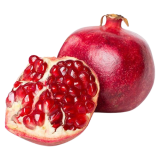Pomegranate
“UNLOCK NATURE’S JEWEL: JUICY POMEGRANATES, BURSTING WITH FLAVOR!”
Nutritional Content of Pomegranate (per 100g)
Calories
83
Sugars
9.2g
Carbohydrates
18.7g
Protein
1.7g
Fiber
4.0g
Fat
1.2g
Vitamin C
10.2mg (17% of the daily recommended intake)
Folate
38µg (10% of the daily recommended intake)
Vitamin K
16.4µg (21% of the daily recommended intake)
Potassium
236mg (7% of the daily recommended intake)
Health Benefits of Pomegranates
Rich in Antioxidants
Pomegranates are packed with powerful antioxidants, such as punicalagins and anthocyanins, which help protect cells from oxidative damage.
Heart Health
Consuming pomegranates may improve heart health by reducing blood pressure, lowering bad cholesterol levels, and preventing plaque buildup in arteries.
Cancer Prevention
Some studies suggest that pomegranate extract may inhibit the growth of cancer cells and reduce the risk of certain cancers.
Anti-Inflammatory
Pomegranates have anti-inflammatory properties that can help reduce inflammation in the body and alleviate symptoms of chronic diseases.
Rich in Fiber
The high fiber content supports digestive health and aids in regular bowel movements.
Improves Memory
Pomegranates may have neuroprotective effects and help improve memory and cognitive function.
Bursting with Health and Flavor!
Recommended Daily Intake
There is no specific daily intake of pomegranates, but incorporating this fruit into your diet a few times a week can provide various health benefits. Consuming a medium-sized pomegranate or a glass of fresh pomegranate juice a few times a week is a good practice.
Best Time to Eat Pomegranates
Pomegranates can be consumed at any time of the day. Some people prefer to eat them in the morning as part of their breakfast, while others enjoy them as a refreshing snack or use them in salads and desserts.
How Pomegranates Grow
Pomegranates grow on small, deciduous trees or shrubs known as Punica granatum. These trees produce vibrant red or yellow flowers that eventually develop into the fruit. The round, leathery-skinned pomegranate fruit contains numerous seeds, each surrounded by juicy arils.
Places Where Pomegranates are Grown
Pomegranates are cultivated in various regions across the world, but they thrive in Mediterranean climates. Major pomegranate-producing countries include India, Iran, Turkey, the United States, and Spain. In India, pomegranates are grown in states like Maharashtra, Andhra Pradesh, and Karnataka.
Types and Varieties
There are many different varieties of pomegranates, each with its own unique taste and characteristics. Varieties offer a range of flavor profiles and are used in various culinary applications, from juices and salads to desserts and garnishes. Pomegranates are celebrated not only for their delicious taste but also for their impressive health benefits. Including this fruit in your diet can be a flavorful way to enhance your overall well-being.
Wonderful
Known for its sweet and tangy taste, deep red arils, and high juice content.
Ruby Red
Features soft, sweet, and aromatic arils with a mild flavor.
Hicaz
A Turkish variety known for its large fruit and sweet-tart flavor.
Bhagwa
An Indian variety with sweet and juicy arils and a deep red color.




















 Mango
Mango Banana
Banana Pomegranate
Pomegranate Guava
Guava Papaya
Papaya Apple
Apple Orange
Orange Kiwi
Kiwi Strawberry
Strawberry Grapes
Grapes Watermelon
Watermelon Sapota
Sapota Amla
Amla Pineapple
Pineapple Coconut
Coconut Spinach
Spinach Broccoli
Broccoli Tomatoes
Tomatoes Carrots
Carrots Cabbage
Cabbage Bell Peppers
Bell Peppers Cauliflower
Cauliflower Bitter Gourd
Bitter Gourd Eggplant
Eggplant Okra
Okra Green Peas
Green Peas Onions
Onions Garlic
Garlic Pumpkin
Pumpkin